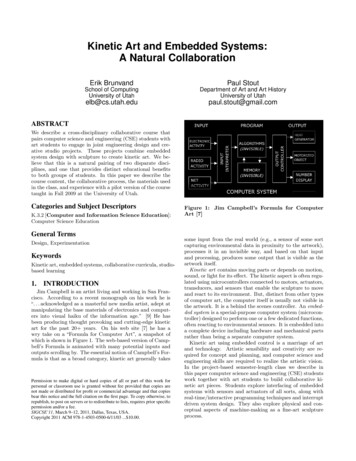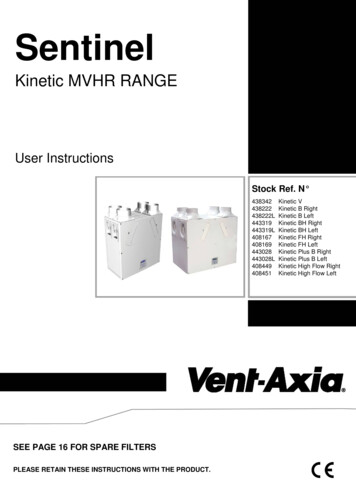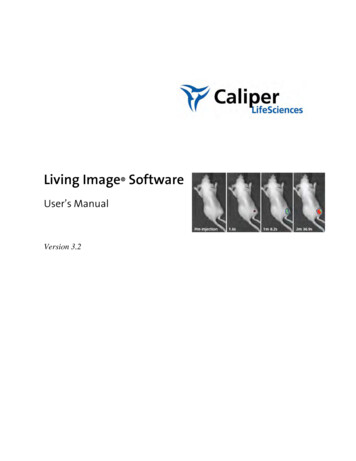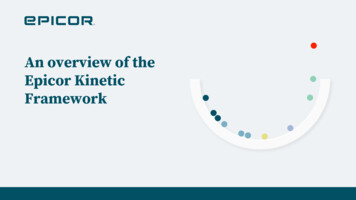
Transcription
Kinetic Art and Embedded Systems:A Natural CollaborationErik BrunvandPaul StoutSchool of ComputingUniversity of UtahDepartment of Art and Art HistoryUniversity of Utahelb@cs.utah.edupaul.stout@gmail.comABSTRACTWe describe a cross-disciplinary collaborative course thatpairs computer science and engineering (CSE) students withart students to engage in joint engineering design and creative studio projects. These projects combine embeddedsystem design with sculpture to create kinetic art. We believe that this is a natural pairing of two disparate disciplines, and one that provides distinct educational benefitsto both groups of students. In this paper we describe thecourse content, the collaborative process, the materials usedin the class, and experience with a pilot version of the coursetaught in Fall 2009 at the University of Utah.Categories and Subject DescriptorsK.3.2 [Computer and Information Science Education]:Computer Science EducationGeneral TermsDesign, ExperimentationKeywordsKinetic art, embedded systems, collaborative curricula, studiobased learning1.INTRODUCTIONJim Campbell is an artist living and working in San Francisco. According to a recent monograph on his work he is“. . . acknowledged as a masterful new media artist, adept atmanipulating the base materials of electronics and computers into visual haiku of the information age.” [9] He hasbeen producing thought provoking and cutting-edge kineticart for the past 20 years. On his web site [7] he has awry take on a “Formula for Computer Art”, a snapshot ofwhich is shown in Figure 1. The web-based version of Campbell’s Formula is animated with many potential inputs andoutputs scrolling by. The essential notion of Campbell’s Formula is that as a broad category, kinetic art generally takesPermission to make digital or hard copies of all or part of this work forpersonal or classroom use is granted without fee provided that copies arenot made or distributed for profit or commercial advantage and that copiesbear this notice and the full citation on the first page. To copy otherwise, torepublish, to post on servers or to redistribute to lists, requires prior specificpermission and/or a fee.SIGCSE’11, March 9–12, 2011, Dallas, Texas, USA.Copyright 2011 ACM 978-1-4503-0500-6/11/03 . 10.00.Figure 1: Jim Campbell’s Formula for ComputerArt [7]some input from the real world (e.g., a sensor of some sortcapturing environmental data in proximity to the artwork),processes it in an invisible way, and based on that inputand processing, produces some output that is visible as theartwork itself.Kinetic art contains moving parts or depends on motion,sound, or light for its effect. The kinetic aspect is often regulated using microcontrollers connected to motors, actuators,transducers, and sensors that enable the sculpture to moveand react to its environment. But, distinct from other typesof computer art, the computer itself is usually not visible inthe artwork. It is a behind the scenes controller. An embedded system is a special-purpose computer system (microcontroller) designed to perform one or a few dedicated functions,often reacting to environmental sensors. It is embedded intoa complete device including hardware and mechanical partsrather than being a separate computer system.Kinetic art using embedded control is a marriage of artand technology. Artistic sensibility and creativity are required for concept and planning, and computer science andengineering skills are required to realize the artistic vision.In the project-based semester-length class we describe inthis paper computer science and engineering (CSE) studentswork together with art students to build collaborative kinetic art pieces. Students explore interfacing of embeddedsystems with sensors and actuators of all sorts, along withreal-time/interactive programming techniques and interruptdriven system design. They also explore physical and conceptual aspects of machine-making as a fine-art sculptureprocess.
The overall goal of the course is to enhance the educationalexperience for both groups of students. From the CSE sidewe encourage students to apply their technical skills in acontext that is explicitly non-technical. This can allow students the freedom to try a wide range of approaches to aparticular problem. In the process, engineers are exposed toa variety of aesthetic and creative concepts that would notnormally be part of an engineering curriculum. Artists explore programming and engineering in a context that is moreconducive to their learning style because it is directed at artmaking. Both groups of students gain practical experiencein design-thinking which is quite distinct from the computational thinking that is usually more associated with CSE. Byrequiring that the project groups include both engineers andartists, the students contribute to their own learning and creative growth through peer teaching. The multi-disciplinaryteams allow both groups of students to experience a verydifferent approach to problem solving because of their different fields. Learning to communicate across disciplines,and perhaps just as importantly respect each other’s skillsand contributions, is vitally important for successful collaboration. The overall result is that both student groups gainsignificant and unusual benefits that they can apply to awide variety of aspects in their respective disciplines.2.CURRICULUMOur collaborative course is listed both as a CS course andas an Art course. The course is an upper division undergraduate course in both departments so we can assume thatthe CSE students are capable programmers and that theArt students are capable 3d artists. Students sign up forthe course in their own discipline, but the classes meet together and the instructors team-teach all sessions. As wewere planning the course this presented some challenges,mostly as we considered the amount of background material that each group of students might need in the othergroup’s field of study. We considered breaking the class intotwo groups for the first part of the semester with the artistsstudying CS topics and the CSE students studying art. Inthe end we decided to keep all students together throughout the semester with the hope that students would rise tothe occasion to contribute peer teaching to the curriculumwhen appropriate. We also considered the other extreme ofpairing students at the beginning of the course, but wereconcerned that students from each discipline would rely toomuch on their counterpart and not attempt some of the material themselves.The overall curriculum consists of review topics and individual assignments for the first four to five weeks of thesemester, followed by a group project phase using a studiobased instruction model. This worked quite well in the pilotcourse. The topics covered include the following:Computer Science and Engineering Topics– Programming fundamentals– Electronics fundamentals– Input sensors (switches, potentiometers, resistive sensorsincluding light, temperature, flex, etc., rangefinders, opticalswitches, etc.)– Output actuators (servos, DC motors, stepper motors,LEDs, relays, switching transistors, etc.)– Programming reactive systems– External chip interfacing with protocols such as SPI– Interrupt programmingArt and Design Topics– Art history review of kinetic art– Discussion of contemporary kinetic artists (Jim Campbell,Jack Dollhausen, Arthur Ganson, Rebecca Horn, Dan Rozin,Sabrina Raaf, Alan Rath, Peter Vogel, etc.)– Formal elements of 3d art such as aesthetics, proportion,and balance– Material studies (plastic, metal, paper, wood, etc.)– Mechanical linkages and physical construction– Concepts and meaning in art– Artistic design processNote that for each group of students, some of these topicswill be review, and some will be brand new. For example,the first programming lab session is basic review for the CSEstudents, but may be the first time an art student has attempted to write a program of their own. From the otherside, the fundamentals of 3d art is a review for the art students, but is perhaps the first time a CSE student has considered the ideas. While this has the potential to be “boring”to some of the students, we were pleasantly surprised in thepilot class that students seemed willing to take the reviewsseriously, and help out during the hands-on activities.Class proceeds with a set of individual assignments ofgradually increasing complexity in both engineering and artistic aspects. These assignments introduce new programmingconcepts, give students experience with the range of sensorsand actuators they can use, and practice building sculpturalart pieces. After this phase, the students are partitioned intoteams of three to four students where each team includesboth engineers and artists. The teams proceed to work ontwo or three collaborative projects during the course of thesemester. In our pilot offering of the course in 2009 we usedteams of three and shuffled the teams after each project sothat all students worked with a variety of different studentsthroughout the semester.An obvious question about the curriculum is how the subjects covered compare to a traditional CSE embedded systems course. Clearly because of the added art content, ourkinetic art course cannot cover the same range of purely CSEmaterial. In terms of strictly CSE content we cover interfacing to sensors and actuators in much more detail than ourregular embedded systems course, but do not cover as muchmaterial related to assembly programming, advanced C programming, program optimization, or analysis of embeddedprograms.The class culminates in a gallery show of the projects.This is a powerful motivator for the student groups to create interesting, thoughtful, and most importantly finishedworks by the end of the semester. A gallery show not onlyadds to the art students’ portfolios, it can be an interestingresume line for the CSE students as well. We worked withthe gallery in the Department of Art and Art History afterthe course in Fall 2009, and based on the success of thatshow are negotiating with other galleries in Salt Lake Cityfor a show after this Fall’s offering of the course.2.1Studio Art Educational ModelsPedagogical modes in engineering and fine art are typically quite different in both direct and subtle ways. Onemajor difference is the use of studio-based instruction in the
fine arts. Studio-based learning emphasizes collaboration,design-thinking, interaction, and learn-by-doing approaches.It forms the core of most fine art and design curricula [16,21]. At the core of a studio-based curriculum are the ideasof exploring a multitude of design alternatives (design thinking) and the evaluation of those designs through peer groupcritiques (collaboration). These peer critiques serve a verydifferent role for the student from graded assignments oreven from engineering design reviews. Because students arediscussing, evaluating, and critiquing each other’s work, thiscan create a much more collaborative, supportive, and lesshierarchical learning environment than traditional engineering courses with lectures and individually completed lab assignments.Our course includes peer design critiques at both formative and completed project phases. This is natural for theart students, but can be intimidating to the CSE students atfirst. We found that it takes a few critique sessions for theCSE students to feel comfortable with the process. Becausethe designs are not “regular” CSE projects, we feel that thisenvironment allows the CSE students to more comfortablyadjust to the critique process. That is, because the subjectof the critiques is (for the most part) art, their CSE skillsare not necessarily on the line.Although studio-based curricula are the norm in fine artsand design fields (such as industrial design, architecture,graphic design, etc.), they are not common in engineering.Recently there have been some intriguing studies on howa more collaborative [4, 35, 27, 10] or studio-type curriculum [21, 6, 19, 20, 17] might be adapted for CSE. We findthese approaches very interesting from a broader CSE pointof view, but view them as essential for our proposed kineticart curriculum. One of our ongoing curriculum development challenges is to fit the programming, computing, andengineering construction course content into this type of exploratory, collaborative studio environment. A longer termgoal is to contribute to the growing body of knowledge abouthow a studio model meshes with a broader CSE curriculum.2.2Enhancing CreativityComputer scientists and computer engineers who exhibithigh levels of creativity and interdisciplinary design visionare highly valued in their communities, and are often identified with leadership roles in research, development, andeducation. Creativity is clearly a tremendous asset whenfaced with a challenging problem, and students who canwork across disciplines are a natural fit for many areas ofCSE studies. However, students with this powerful combination of traits are seen as somewhat rare in CSE. One ofthe exciting ancillary benefits of this kinetic art and embedded systems course is the potential to enhance the creativityof our CSE students.In this course, technical students are encouraged to apply their technical skills in a context that is explicitly nontechnical. This not only forces students to think aboutproblems and solutions in a very different way, but alsogives them an environment where they can feel able to propose and explore solutions where aesthetics are a primarygoal, not engineering costs and practicalities. This freedomto explore “impractical” solutions is, we believe, a powerful creativity enhancer. One interesting model of creativitydefines enhanced creative problem solving in the followingway: “Creativity is demonstrated by the generation of manypotential solutions instead of gravitating quickly toward asingle and (usually) familiar solution that is not necessarilythe optimal one.” [11]Thinking outside the normal scope of engineering projectscan have a profound impact on how engineers and computerscientists approach all their designs. Students who havemore creative, artistic design in their engineering vocabulary should be able to design better human interfaces, makesystems more usable, extendable, and testable, and be morewilling to take novel and unconventional approaches. Wethink of this as extending the palette available when considering the design of a new system, whether that systemis software, hardware, mechanical, or a combination of all.There are a number of researchers who report that interdisciplinary collaborations are a powerful catalyst for creativity [27, 8, 4, 35].Another aspect of creative problem solving is embodiedin the actual construction of a physical artifact. The rootof the word “creativity” itself implies the creation of something. There is evidence that creativity is enhanced by engaging in studio courses where the projects involve physicalartifacts [12, 10, 32, 18].3.COURSE FACILITIESThe primary facilities required for a course of this type arestudio space that supports the exploration and constructionof moderately complex 3d assemblages, a variety of sensorsand actuators that the students can use, and a microcontroller platform for control.In terms of studio space our class is able to use the 3d design studios in the Department of Art and Art History. Thisincludes separate wood and metal shops, as well as open studio space for project construction. In terms of sensors andactuators, we received a small grant from the University ofUtah Teaching Committee to support our pilot class in Fall2009 and used that, in part, to stock our lab with initialsupplies. A modest class fee for subsequent classes will beused to restock and acquire a variety of components for thelab. These components (servos, motors, LEDs, light sensors, resistors, etc.) are for the most part quite inexpensiveranging from a few pennies to a few dollars each.For the microcontroller platform there are a variety ofchoices available. The choice of a controller can have a largeimpact on the class because the control of the kinetic artis critical, and different controllers have quite different features and programming environments. We have chosen touse the Arduino embedded controller and associated programming environment [2]. The Arduino is an open-sourceelectronics prototyping platform based on an Atmel AVR8-bit microcontroller. The hardware is open-source in thesense that all details of the controller board are made freelyavailable so that users can build their own if they choose.The software integrated development environment (IDE) forprogramming the Arduino hardware is also called Arduino,and is a set of C-language functions designed to be relativelyeasy for any user to quickly write programs that use the Arduino hardware to sense and control the physical world.Although the Arduino contains many interesting I/O properties and features, it is quite affordable. The basic boardwe are using is the Arduino Duemilanove which has 14 digital I/Os, 6 Analog inputs, 1 UART, and a variety of otherfeatures on a 2.7 X 2.1 inch board and costs around 30 (SeeFigure 2). The development and programming environment
nal through those plates to sense the capacitance ofthe person and increases the light output when someone is touching the plates. As more people join handsand make a human chain between the plates, the lightgrows brighter and the gears turn casting a dynamicshadow on the wall. Drone-like sound effects are alsoplayed during this process. The piece is meant to evokethe idea of a mystical relic that responds to cooperation by the viewers. The more viewers join the human chain, the brighter and more dynamic the relicbecomes.Figure 2: An Arduino Duemilanove board which isbased on the AVR ATmega 328p microcontroller.is open source and available free of charge in PC, Mac, andLinux versions. The Arduino programming IDE is reallyC/C , but with a set of useful functions predefined for theuser. The back-end of the IDE is the gcc compiler [15] whichmeans that advanced users can use the full C/C programming language, and access all the internal features ofthe Atmel chips. Because Arduino hardware is programmedthrough the USB port of the host computer (acting as a serial interface), no additional programming hardware needsto be purchased.Although the Arduino is a relative newcomer to the microcontroller world (compared to PIC and Basic Stamp, forexample), it already has a wide following which results inmany informative web sites that students can access [13, 14,25]. There are also a number of books that describe usingArduino for controlling and sensing the physical world [29,22, 5].4.PILOT COURSEA pilot version of the course was taught by the authorsin Fall semester 2009. The enrollment was fairly small withsix CSE and three art students participating. All aspectsof the curriculum in Section 2 were covered, and a total ofthree group projects were completed by each of the threeinterdisciplinary teams. Because of the small class size,we were able to shuffle the teams such that every studentworked on a team with every other student at some timeduring the semester, and all teams consisted of both artistsand engineers. The course culminated with a gallery showin the Gittins Gallery in the Department of Art and ArtHistory in January 2010. The show consisted of all ninegroup project pieces and was widely viewed as a successfulshow by other faculty in both departments (see Figure 3 andhttp://www.eng.utah.edu/ cs5968/pictures).Some details of a few of the final kinetic art projects fromFall 2009 are:Relic: This large floor-standing piece (seen in Figure 3) wasconstructed of wood and metal with stepper motors,light bulbs, and electronic (Arduino) control. Standing in front of the piece the viewer sees a triangularthemed structure with a dim light in the center casting a shadow of some gears on the wall behind. Thereare two metal plates on either side of the piece withhand prints on them inviting the viewer to place theirhands there. The piece sends a very low voltage sig-Cars: In this piece a large eight foot square white board wasset up as a table. On the table are two small remotecontrol cars, stripped to their chassis, and each dragging a white board marker. The cars are controlledby Arduinos hidden under the table. The turning anddirection of the cars is changed in response to characters received on internet RSS feeds so that the patternsdrawn on the white boards are in some way a physicalrepresentation of the data coming across that internetfeed. By placing paper under the cars a permanentrecord of the drawing can be made.Flowers: In this piece eight kinetic flowers (each around18” in diameter) were constructed from plastic, foam,paint, and servos controlled by an Arduino (see Figure 3). At the center of each flower is a light sensor.When left on their own the petals of the flowers moveslowly up and down in a random fashion that lookscalm. When a viewer moves close enough to changethe amount of light on the sensor however, the flowers become agitated and exhibit a variety of differentfrightened or angry behaviors until the viewer backsaway.Windchime: This piece consists of a wind chime constructedfrom copper tubing for the chimes, and a decorativemetal housing as the support. At the center of thechimes is a metal striker. As the striker hits each ofthe chimes, a switch connection is made and a differentset of LEDs in the main housing illuminates. A gentle breeze provides a constantly changing set of soundsand colors.The student evaluations of the course were very positivewith numeric scores above the department and college averages. The most striking thing about the comments wasthe degree to which students in each demographic groupwere positive about the experience of working on such wildlymulti-disciplinary teams. Some representative student comments include: “It was really great to learn how to workwith other students (art, cs, ece) like on the job.” “I reallyenjoyed the open interaction that all the students had witheach other and with the instructors.” “I learned a great dealabout electronics and embedded programming that I hadnot learned previously in my engineering courses. For me,it put into practice and solidified what we covered in theearlier engineering courses.”We are encouraged that the enrollment in our Fall 2010course is more than double our Fall 2009 course. The courseweb page is available at http://www.eng.utah.edu/ cs5968.One of the main lessons we learned in the pilot course wasthat without individual practice in all aspects of the kinetic
Figure 3: Three of the nine finished projects from Invisible Logic, the gallery show from Fall 2009. From theleft they are Relic (wood, metal, light bulbs, motors, electronic control), Underwood 1910 (metal, typewriter,pneumatic actuators, electronic control), and Flowers (plastic, paint, servos, electronic control)art design process, multi-disciplinary teams tended to naturally slip into predefined engineering/art roles. In our secondoffering we are adding more extensive individual projects before forming teams, and will monitor the teams carefully tojudge team participation in all aspects of the projects.Another lesson is that the more hands-on practice withthe materials, the better. We have a variety of sensors andactuators available for the students, but in the end mostart pieces used a small subset of them, mainly servos, LEDsand light sensors. This is partly because those componentsalready provide a great deal of flexibility in how they canbe integrated into the kinetic art, but it likely also becausethey were the components most prominently featured in ourinitial hands-on labs. For our current offering of the coursewe plan to increase the number and type of components usedin the preliminary labs to see if that will result in a widerrange of components being used in the final projects.One lesson that may translate to many other types ofCSE courses is how valuable the process can be of buildingsmall throw-away non-serious prototypes. Students in theFall 2009 semester commented on how liberating it was tosketch rough ideas and try things out on breadboards in classjust to see how the components behaved without worryingabout making every test a completed assignment. As described earlier, one intriguing definition of creativity is howmany designs are explored before a final solution is settledupon. A kinetic art project, along with the ongoing designcritiques in the studio class model, is a perfect opportunityto explore creativity in this way.5.RELATED WORKThe general area of collaboration between arts and technology is quite rich, but many educational collaborations aretargeted specifically at finding ways to introduce technologyto artists, designers, and other non-technical or younger audiences (e.g.,affordable Alice [1, 23], Scratch [33, 26], Processing [30, 31], etc.). We have found only a few examplesof using arts to enhance engineering. Some of those havealready been referenced in this paper and include exploration of how interdisciplinary collaboration in general enhances engineering problem solving [4, 35], how studio-basedcourses make sense as a model for computing courses [12, 21,6], and how the process of making tangible artifacts enhancesengineering problem solving [10, 32, 18, 3].The program most directly related to our Kinetic Art andEmbedded Systems course is the successful Artbotics program at UMass Lowell [24, 28, 34], initiated in 2006. Thisis quite a similar program in some respects. Its main activity involves a curriculum using art and robotics (similar tokinetic art, although it is not described in that way) to helpattract new students to computing disciplines. They arealso connected with a local museum that organizes shows ofthe student’s work. There are many small, but important,differences between Artbotics and our proposed course, butone major difference is that Artbotics is primarily an afterschool program and summer camp for high school students.Artbotics is also somewhat more focused on the robotics aspects of the projects than the fine-art aspects of the projectsalthough this is admittedly somewhat subjective.6.CONCLUSIONS ANDFUTURE DIRECTIONSOur collaborative course builds on the powerful connection between embedded control and kinetic art. This pairingseems like a natural fit, and one with high potential for intriguing results. Engineers are rarely taught to think aboutartistic, conceptual, and aesthetic outcomes, and artists arenot usually taught to think about engineering issues in creating an artistic artifact. The studio model is an intriguingmodel for more general CSE education, but it is perhapsbest experienced in a true studio course. A focus on designthinking also seems to us to be a natural complement tocomputational thinking.There are many opportunities for this sort of collaboration. Many media in the fine arts require the equivalent ofengineering problem solving to master. Kinetic art is themost obvious (and thus is the choice for this course), butsculpture, printmaking, photo, new media, video, installation art, interactive art, and digital media all have aspectsthat would be amenable to collaboration of this sort.Enhanced collaboration between these colleges that are
usually thought of as quite distant could have a profoundimpact on how both engineers and artists are educated. Ourbroader goals are to use this as a building block for furtherconnections between the College of Engineering and the College of Fine Arts at the University of Utah, and to serveas a model that could be adopted at any number of othereducational institutions. Further connections could engagea much wider range of engineering and fine arts students,and explore further fascinating synergies in creative problem solving in both engineering and fine arts.7.ACKNOWLEDGMENTSWe thank the University of Utah Teaching Committee fortheir support of our pilot course in Fall 2009.8.REFERENCES[1] The Alice web page. http://www.alice.org.[2] Arduino home page. http://www.arduino.cc.[3] D. Avrahami and S. E. Hudson. Forming interactivity:a tool for rapid prototyping of physical interactiveproducts. In DIS ’02: Designing Interactive Systems,pages 141–146, London, England, 2002.[4] E. E. Ayiter, S. S. Balcisoy, M. Germen, and S. Artut.Propagating collaboration: an instructionalmethodology for artists and engineers. In SIGCHIC&C ’07, Washington, DC, USA, 2007.[5] M. Banzi. Getting Started with Arduino (Make:Projects). Make Books, 2008.[6] L. J. Barker, K. Garvin-Doxas, and E. Roberts. Whatcan computer science learn from a fine arts approachto teaching? In SIGCSE ’05, St. Louis, Missouri,USA, 2005.[7] J. Campbell. Artist’s web site.http://www.himcampbell.tv.[8] L. Candy and E. Edmonds. Explorations in art andtechnology. Springer-Verlag, London, UK, 2002.[9] S. Dietz, editor. Jim Campbell: Material Light. HatjeCantz, 2010.[10] E. Y.-L. Do and M. D. Gross. Environments forcreativity: a lab for making things. In SIGCHI C&C’07, pages 27–36, Washington, DC, USA, 2007.[11] E. Edmonds and L. Candy. Creativity, art practice,and knowledge. Commun. ACM, 45(10):91–95, 2002.[12] E. A. Edmonds, A. Weakley, L. Candy, M. Fell,R. Knott, and S. Pauletto. The studio as laboratory:combining creative practice and digital technologyresearch. Int. J. Hum.-Comput. Stud.,63(4-5):452–481, 2005.[13] The world famous index of arduino and freeduinoknowledge. http://www.freeduino.org.[14] L. Fried. Arduino tutorial.http://www.ladyada.net/learn/arduino.[15] Gcc, the GNU compiler collection. http://gcc.gnu.org.[16] L. N. Green and E. Bonollo. Studio-based teaching:history and advantages in the teaching of design.World Transactions on Eng. and Tech. Edu.,2(2):269–272, 2003.[17] D. Hendrix, L. Myneni, H. Narayanan, and M. Ross.Implementing studio-based learning in CS2.
Clearly because of the added art content, our kinetic art course cannot cover the same range of purely CSE material. In terms of strictly CSE content we cover interfac- . design-thinking, interaction, and learn-by-doing approaches. It forms the core of most ne art and design curricula [16, 21]. At the core of a studio-based curriculum are the .










